第三章 文艺复兴时期的玻璃器
公元15 世纪中期,第一件用“千花”工艺(millefiori )和“嵌线”工艺(vetro a filigrana ,线纹装饰玻璃)制作的玻璃器在意大利威尼斯诞生。这些装饰方法在公元16、17 世纪广泛流行。热定型玻璃,光学玻璃,裂纹玻璃都是这个时期玻璃工艺精练的产物。随着威尼斯玻璃工匠的迁移,仿威尼斯玻璃制品(威尼斯式)传遍西欧和中欧。公元17 世纪末期,玻璃切割和雕刻在中欧得以复苏。其代表人物卡斯帕·莱曼(Caspar Lehmann, 1563- 或1564-1662)是一名宫廷玻璃及珠宝雕刻师,在布拉格为鲁道夫二世皇室工作(哈布斯堡王室)。除了玻璃雕刻,文艺复兴时期的玻璃装饰技术还有钻石点刻(威尼斯,加泰罗尼亚,中欧)、珐琅彩(威尼斯,中欧)、冷装饰工艺—用颜色釉料和粘胶剂进行彩绘装饰(中欧)以及热装饰工艺等。玻璃反画(在玻璃的背面作画)则是当时另一种非常流行的冷加工工艺技术。
Glass of the Renaissance Period
Around the mid-15th century, the first objects in the millefiori and vetro a filigrana (glass with threads) techniques were made in Venice, Italy. These methods of decorating glass enjoyed the greatest popularity in the 16th and 17th centuries. Hot-formed glass, optical decoration and crackle glass were some of the glass-refining processes of this period. With the emigration of glass masters from Venice, glass made in imitation of Venetian products (fa?on de Venise) spread throughout western and central Europe. In the last third of the 17th century, glass cutting and engraving was revived in central Europe. Caspar Lehmann (1563– or 1564–1622), a court glass and gemstone engraver, was employed at the Prague Court of Emperor Rudolf II (The House of Habsburg). Apart from carved glass, glass-decorating techniques of the Renaissance included diamond-point engraving (Venice, Catalonia, Central Europe), enamel painting (Venice, Central Europe), cold decoration – with surfaces painted in oils and mastic (Central Europe) and, of course, decoration of glass while hot. Underpainted glass (reverse painting on glass sheets) was another popular cold-working technique.
III 文艺复兴时期的玻璃器Glass of the Renaissance Perio
(1)文艺复兴时期威尼斯和欧洲北方的珐琅彩绘玻璃器Enamel-Painted Venetian and Northern Glass of the Renaissance Period

16
圈足盘
意大利威尼斯,16世纪上半叶
透明玻璃,珐琅彩绘并镀金;直径 21.3 cm
编号 9 628
1906年布拉格的沃伊切克·兰尼捐赠
这是一件水果盘,圈足短而外撇,通体描金并绘珐琅彩,宽沿,深腹带棱。圆形盘底镀金,中心珐琅点彩,并彩绘白、蓝、红三色。口沿贴金箔,同样珐琅点彩。随着欧洲与东地中海地区贸易往来,威尼斯引进了新的玻璃工艺,使用艳丽的珐琅彩(约摄氏450-550度烧成)装饰玻璃,最晚从13世纪起,至16世纪进入巅峰。
Footed plate
Italy, Venice, beginning of 16th century
Colourless glass, enamel and gold painted; Diameter 21.3 cm
Inv. no. 9?628
Donated in 1906 by Vojtěch Lanna, Prague
This clear-glass platter (frutiera in Italian) served as a fruit plate. It is is set on a short, flaring, circular foot and painted in enamels and gold. The bowl-shaped dish is ribbed and opens into a wide rim. In the centre inside is a gilded disc, heightened with enamel dots and painted in white, blue and red. The rim is decorated with a gold-leaf border, also complemented with enamel dots of the same colours. Introduced through trade exchanges with the eastern Meditteranean region, the process of decorating glass with bright enamels (fired at a temperature c. 450–550 degrees Celsius) was employed in Venice from no later than the 13th century. The technique reached its peak in the 16th century.
HB

17
圈足碗
意大利威尼斯,16世纪上半叶
透明玻璃,珐琅彩绘并描金;直径 20.5 cm
编号 79 094
1963年收购
Footed bowl
Italy, Venice, 1st half of 16th century
Colourless glass, enamel and gold painted; diameter 20.5 cm
Inv. no. 79?094
Acquired in 1963
HB
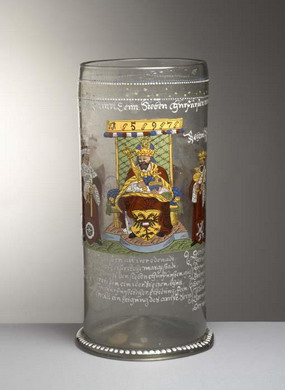
18
啤酒杯,绘有神圣罗马帝国皇帝和选帝侯形象
波希米亚,1597年
淡绿色玻璃,珐琅彩绘;高26 cm
编号 9 883
1906年布拉格的沃伊切克·兰尼捐赠
这件啤酒杯上绘有神圣罗马帝国皇帝鲁道夫二世像,其周围围绕着选帝侯像。这类题材常见于中欧文艺复兴玻璃器上,颇受欢迎,其灵感来自哈特曼·舍德尔所著的《纽伦堡编年史》(纽伦堡1493)。该书以一个欧洲人的视角描述已知世界,其中包括布拉格的最早描述(页码229-230)。绘有这一题材及其他类似题材(皇家雄鹰或马背上的选帝侯等)的酒杯,宣扬并象征着中欧各国的统一,也表达了酒杯使用者对哈布斯堡王朝的忠诚。
Beaker depicting the Emperor and Electors of the Holy Roman Empire
Bohemia, 1597
Light green glass, painted with coloured enamels; H. 26 cm
Inv. no. 9?883
Donated in 1906 by Vojtěch Lanna, Prague
This beaker (Humpen in German) featuring an image of the Emperor (Rudolf II) surrounded by electors shows a widely popular theme that frequently appeared on Renaissance glass in central Europe. Its decoration was inspired by an illustration from the famous Liber chronicarum authored by Hartmann Schedel (Nuremberg 1493), a chronicle of the then-known world, written from a European’s perspective. The chronicle holds the earliest representation of Prague (fol. 229–230). These and other similar beakers – one painted with the Imperial Eagle and another with an elector on horseback – propagated and symbolized the unity of central European countries, while also expressing the loyalty of the vessel’s owner to the ruling House of Habsburg.
HB
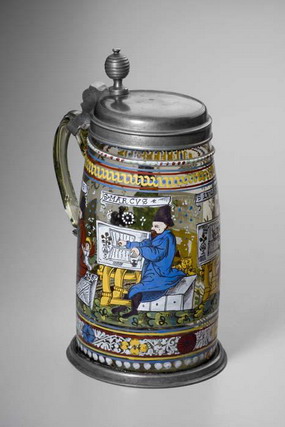
19
绘有四位福音传道者的啤酒杯
波希米亚,1610年
淡绿色玻璃,珐琅彩绘,镶锡托;高21.5 cm
编号 9 953
1906年布拉格的沃伊切克·兰尼捐赠
此啤酒杯圆锥形,略鼓腹,配锡盖、锡托,上部饰一周辫纹,下部饰一周花草纹,两条纹饰之间绘四位福音传道者——马太、路加、马可和约翰,他们各自坐在长凳上撰写着《新约》中的《四福音书》。
Humpen showing the Four Evangelists
Bohemia, 1610
Light green glass, painted in enamels, tin; H. 21.5 cm
Inv. no. 9?953
Donated in 1906 by Vojtěch Lanna, Prague
Depicted on the surface of this conical, slightly bulbous tankard with a tin lid and a tin-mounted base, between friezes of braids and plant ornament, are the Four Evangelists – Matthew, Luke, Mark and John, seated on benches and writing the Gospels, the essential writings of the New Testament.
HB

20
绘有牧师、布谷鸟和磨刀石的啤酒杯
波希米亚或德国,1608年
无色透明玻璃,珐琅彩绘;高18 cm
编号 9 909
1906年布拉格的沃伊切克·兰尼捐赠
Humpen with the figures of a priest, cuckoo and whetstone
Bohemia or Germany, 1608
Colourless glass, painted in enamels; H. 18 cm
Inv. no. 9?909
Donated in 1906 by Vojtěch Lanna, Prague
HB
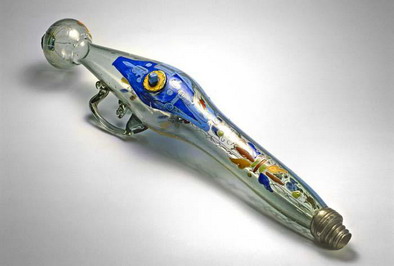
21
枪式瓶
波希米亚,17世纪
无色透明玻璃,热成形,珐琅彩绘,锡托架;长40 cm
编号 9 963
1906年布拉格的沃伊切克·兰尼捐赠
这件手枪形长颈瓶忠实地再现了一种16世纪的新玩意儿——燧发机结构的火枪。这些简朴的长颈瓶往往只彩绘一些图案,直至18世纪还在波希米亚生产。
Pistol-shaped bottle
Bohemia, 17th century
Colourless glass, hot-shaped, painted in enamels, tin mounting; L. 40 cm
Inv. no. 9?963
Donated in 1906 by Vojtěch Lanna, Prague
This flask in the form of a pistol is a faithful rendering of a 16th-century novelty – a firearm fitted with a wheel-lock mechanism. These vessels, often also made of coloured glass and undecorated, were produced in Bohemia until the 18th century.
HB
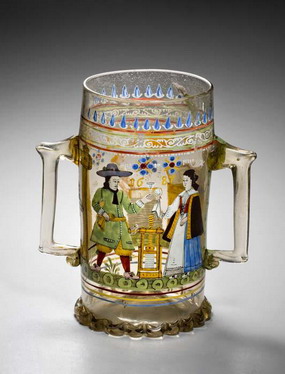
22
双把啤酒杯
波希米亚,奥雷山脉,菲希特尔伯格,1687年
淡绿色玻璃,珐琅彩绘;高20.5 cm
编号 52 202
1961年购自布拉格的一家首饰店
Humpen with two handles
Bohemia, Fichtelberg in the Ore Mountains, 1687
Light green glass, painted in enamels; H. 20.5 cm
Inv. no. 52?202
Purchased in 1961 from a Klenoty shop, Prague
HB
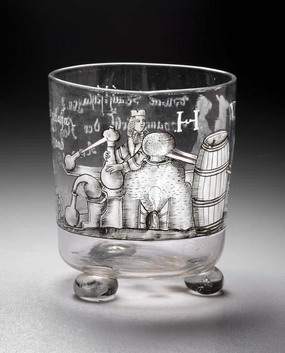
23
绘有蒸馏酒厂的酒杯
法兰克尼亚或波希米亚,1689年
无色透明玻璃,白、黑两色珐琅彩绘;高10.4 cm
编号 10 404
1906年布拉格的沃伊切克·兰尼捐赠
这件酒杯圆柱形杯身,下承三个球形足,同样款式也见于金属器皿。杯身绘一男士手持酒杯并一女士立于蒸馏器旁,上题箴言“不花功夫,听再多的建议也无用。1689年”和花押字母“H.V.”。
Beaker with a painting of a distillery
Franconia or Bohemia, 1689
Colourless glass, painted in white and black enamels; H. 10.4 cm
Inv. no. 10?404
Donated in 1906 by Vojtěch Lanna, Prague
This cylindrical beaker mounted on three globular feet repeats the shape of contemporary goldsmithing products. The surface is decorated with the figures of a gentleman holding a beaker and a lady at a distillation apparatus, and an inscription that reads: “Mit Rath-Schlagen ist nicht getahn, wann nicht der Flei3 legt Hand. Anno 1689”(Without dilligence, all advice comes to naught) and the monogram “H.V.”
HB
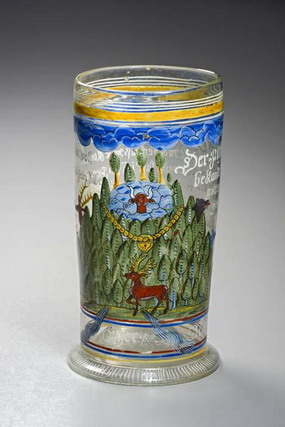
24
绘有牛头的啤酒杯
德国,巴伐利亚,奥雷山脉,菲希特尔伯格,1711年
无色透明玻璃,珐琅彩绘;高20 cm
编号 66 662
1965年购自布拉格的一家图塞克斯商店(类似于中国的友谊商店)
Humpen with a view of Ochsenkopf
Germany, Bavaria, Fichtelberg in the Ore Mountains, 1711
Colourless glass, painted in enamels; H. 20 cm
Inv. no. 66?662
Purchased in 1965 from a Tuzex store, Prague
HB
(2)文艺复兴时期带纹饰的热处理威尼斯玻璃器
Hot-formed and Decorated Venetian Glass of the Renaissance Period

25
有盖高脚酒杯
意大利,威尼斯,16世纪下半叶
无色透明玻璃,热成形;高21 cm
编号 8 686
1906年布拉格的沃伊切克·兰尼捐赠
Covered goblet
Italy, Venice, 2nd half of 16th century
Colourless glass, hot-shaped; H. 21 cm
Inv. no. 8?686
Donated in 1906 by Vojtěch Lanna, Prague
HB
26
高脚酒杯
意大利,威尼斯,16世纪
无色透明玻璃,热成形,镀金;高19.5 cm
编号 30 387
1948年购自布拉格的兹德涅克·耶扎贝克拍卖会
这只高脚酒杯,原有盖,盖上有个十字架把手,杯身饰凸起的菱形花纹。酒杯脚呈栏杆立柱状,上饰两个背对背狮子头。这件酒杯很可能是圣礼容器,用来盛放圣餐(酒)的,这类容器通常为金属器皿。
Goblet
Italy, Venice, 16th century
Colourless glas, hot-shaped, gilded; H. 19.5 cm
Inv. no. 30?387
Purchased in 1948 at the Zd. Je?ábek Auction, Prague
The goblet (originally with a lid surmounted by a cruciform knop) is decorated with a raised diamond pattern. The cup is set on a baluster-shaped, gilded foot featuring two macaroons with lions’ heads. In all probability, this receptacle was a ciborium – a receptacle usually made of metal for holding Eucharist hosts.
HB | 